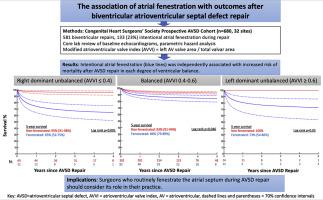The Journal of Thoracic and Cardiovascular Surgery ( IF 6 ) Pub Date : 2021-09-08 , DOI: 10.1016/j.jtcvs.2021.06.067 Connor P Callahan 1 , Anusha Jegatheeswaran 1 , David J Barron 1 , S Adil Husain 2 , Stephanie Fuller 3 , David M Overman 4 , Brian W McCrindle 5 ,

|
Objective
During repair of atrioventricular septal defect (AVSD), surgeons may leave an atrial level shunt when concerned about postoperative physiology, or as part of routine practice. However, the association of fenestration with outcomes is unclear. We sought to determine factors associated with mortality after biventricular repair of AVSD.
Methods
We included 581 patients enrolled from 32 Congenital Heart Surgeons’ Society (CHSS) institutions from Jan. 1, 2012 – June 1, 2020 in the CHSS AVSD cohort. Parametric multiphase hazard analysis was used to identify factors associated with mortality. A random effect model was used to account for possible inter-site variability in mortality.
Results
An atrial fenestration was placed during repair in 133/581 (23%) patients. Overall five-year survival after repair was 91%. Patients who had fenestration had an 83% 5-year survival versus 93% for those not fenestrated (p<0.001). Variables associated with mortality by multivariable hazard analysis included institutional diagnosis of ventricular unbalance (HR=2.7 ( 95% confidence interval: 1.5-4.9), p=0.003), preoperative mechanical ventilation (HR=4.1 (1.3-13.1), p=0.02), atrial fenestration (HR=2.8 (1.5-4.9), p<0.001), and reoperation for VSD (HR=4.0 (1.3-13.1), p=0.002). There was no difference in measures of ventricular unbalance comparing fenestrated to non-fenestrated patients. No significant inter-institution variability in mortality was observed based on the random effect model (p=0.7).
Conclusions
An atrial communication at biventricular repair of AVSD is associated with significantly reduced long-term survival after adjusting for other known associated factors, including unbalance. These findings may challenge the routine practice of fenestration.
中文翻译:

房间隔开窗与房室间隔缺损修复后结果的关联:先天性心脏外科医生协会研究。
客观的
在房室间隔缺损 (AVSD) 修复过程中,外科医生可能会在关注术后生理或作为常规实践的一部分时留下心房水平分流术。然而,开窗与结果的关系尚不清楚。我们试图确定与 AVSD 双心室修复后死亡率相关的因素。
方法
我们在 CHSS AVSD 队列中纳入了 2012 年 1 月 1 日至 2020 年 6 月 1 日期间从 32 个先天性心脏外科医生协会 (CHSS) 机构登记的 581 名患者。参数多阶段风险分析用于确定与死亡率相关的因素。使用随机效应模型来解释死亡率的可能的站点间变异性。
结果
133/581 (23%) 名患者在修复期间放置了心房开窗。修复后的总体五年生存率为 91%。开窗患者的 5 年生存率为 83%,而未开窗患者的 5 年生存率为 93%(p<0.001)。通过多变量风险分析与死亡率相关的变量包括心室失衡的机构诊断(HR=2.7(95% 置信区间:1.5-4.9),p=0.003),术前机械通气(HR=4.1(1.3-13.1),p=0.02 )、心房开窗 (HR=2.8 (1.5-4.9), p<0.001) 和 VSD 再次手术 (HR=4.0 (1.3-13.1), p=0.002)。开窗患者与未开窗患者的心室失衡测量没有差异。基于随机效应模型(p=0.7),未观察到死亡率的显着机构间差异。
结论
在调整其他已知相关因素(包括不平衡)后,AVSD 双心室修复时的心房通信与长期存活率显着降低有关。这些发现可能会挑战开窗的常规做法。


























 京公网安备 11010802027423号
京公网安备 11010802027423号